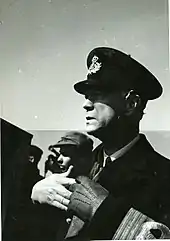Swedish Naval Medical Officers' Corps
Swedish Naval Medical Officers’ Corps[1] (Swedish: Marinläkarkåren, Mlk) was an administrative corps established in 1902 for military physicians in the Swedish Navy and in the Swedish Coastal Artillery. The corps was amalgamated into the Medical Corps of the Swedish Armed Forces in 1969.
History
The Swedish Naval Medical Officers’ Corps was organized in 1902 and included the military physicians of the Swedish Navy and the Swedish Coastal Artillery. Prior to that, the navy's physicians were subordinate to the National Swedish Board of Health. The navy has, as far as the healthcare is concerned, an identical history as the Swedish Army. As early as 1535, so-called bardskärer ("barbers") are mentioned in the navy; they were usually hired for each sea expeditions, after which they were dismissed. There was no initial healthcare at the shipyards, but the sick were usually sent to the respective home towns to be cared for there. Incidentally, these bardskärer or fältskärer were difficult to obtain (the 1567 sea-going fleet of 47 ships had only 17 fältskärer). Moreover, since they would be rather ignorant and the hygienic devices aboard were particularly deficient, great morbidity and mortality ruled the navy and the army, paralyzing military operations. With the arrangement of medical education in Sweden and the formation of the Swedish Army Medical Corps (Fältläkarkåren) in the early 1800s, the conditions improved. However, in the context of the navy's renewal and expansion towards the end of the 1800s, the need for more independent orderly healthcare for the same appeared. The same was also true of the other European navies. The sea duty also required more specifically educated physicians. According to the decision of the state authorities in 1902, the Swedish Naval Medical Officers’ Corps was established. Except for the chief (the Surgeon General of the Swedish Navy, Marinöverläkare) with Captain's (N) rank, there were: 3 first naval surgeons with Commander's rank, 12 naval surgeons of the 1st class with Lieutenant's (N) rank, or possibly with Commander 2nd Class' rank, 20 naval surgeons of the 2nd class with Sub-Lieutenant's rank, or possibly Lieutenant's (N) rank, 12 naval surgeon exhibitioners with Sub-Lieutenant's rank, as well as a reserve with corresponding positions.[2]
In 1925, the Swedish Naval Medical Officers’ Corps consisted of the Surgeon General of the Swedish Navy, 3 first naval surgeons (1 physicians each at Karlskrona and Stockholm naval stations, and 1 fortress physician at Vaxholm Fortress), 13 naval surgeon of the 1st rank (could after 10 years of well-attended service be appointed first naval surgeon), 20 naval surgeons of the 2nd rank (could after 3 years be appointed naval surgeon exhibitioner of the 1st rank), 10 naval surgeon exhibitioners as well as 10 active duty naval surgeon exhibitioners of military age with a Bachelor of Medical Sciences degree or Licentiate of Medical Sciences degree who thus fulfilled their military service. In addition, there was a reserve of physicians.[3]
In 1969, the Swedish Naval Medical Officers’ Corps was amalgamated with the Swedish Army Medical Corps (Fältläkarkåren) and the Swedish Army Veterinary Corps, which formed the Medical Corps of the Swedish Armed Forces.[4]
Chiefs

The chief of the Swedish Naval Medical Officers’ Corps was the Surgeon General of the Swedish Navy (Marinöverläkaren)[lower-alpha 1] and he was commander of the corps and its reserve as well as head of the Royal Swedish Naval Materiel Administration's Sanitation Department. He was to assist the National Swedish Board of Health in dealing with matters concerning the health and medical care in the Swedish Navy and in the Swedish Coastal Artillery, with the right to participate in the deliberations of the Board of Directors on these questions.[6]
- 1902–1917: Karl Leonard Rudberg[lower-alpha 2]
- 1917–1937: Gunnar Nilson
- 1937–1956: Herbert Westermark
- 1956–1969: Lars Troell
Footnotes
- Marinöverläkare is translated as Surgeon General of the Swedish Navy, Surgeon-in-Chief of the [Swedish] Naval Forces or the Director of the [Swedish] Naval Medical Service.[5]
- Rudberg served as Acting Surgeon General of the Swedish Navy from 1902 to 1909, then as Surgeon General of the Swedish Navy from 1909 to 1917. However, he was Chief of the Swedish Naval Medical Officers’ Corps from 1902 to 1917.[7]
References
Notes
- Gullberg 1977, p. 134.
- Westrin 1912, pp. 979–980
- Westrin, Fahlstedt & Söderberg 1925, p. 448
- "Kungörelse (1969:409) med anledning av inrättande av försvarets medicinalkår" (in Swedish). Riksdag. 1969-05-29. Retrieved 11 April 2019.
- Gullberg 1977, p. 520.
- Rikskalendern 1908, p. 240
- Thyselius 1918, p. 328
Print
- Gullberg, Ingvar E. (1977). Svensk-engelsk fackordbok för näringsliv, förvaltning, undervisning och forskning [A Swedish-English dictionary of technical terms used in business, industry, administration, education and research] (in Swedish) (2nd ed.). Stockholm: Norstedt. ISBN 91-1-775052-0. SELIBR 8345587.CS1 maint: ref=harv (link)
- Thyselius, Erik, ed. (1918). Vem är det? 1918: Uppslags- och handbok över samtida kända svenska män och kvinnor (in Swedish). Stockholm: P. A. Norstedt & Söners.CS1 maint: ref=harv (link)
- Westrin, Theodor, ed. (1912). Nordisk familjebok: konversationslexikon och realencyklopedi (in Swedish). 17 (New, rev. and rich illusion. ed.). Stockholm: Nordisk familjeboks förl. SELIBR 8072220.CS1 maint: ref=harv (link)
- Westrin, Theodor; Fahlstedt, Eugène; Söderberg, Verner, eds. (1925). Nordisk familjebok: konversationslexikon och realencyklopedi (in Swedish). 37 (New, rev. and rich illusion. ed.). Stockholm: Nordisk familjeboks förl. SELIBR 8072220.CS1 maint: ref=harv (link)
- Svensk rikskalender 1909 (in Swedish). Stockholm: P. A. Nordstedt & Söner. 1908. SELIBR 498191.